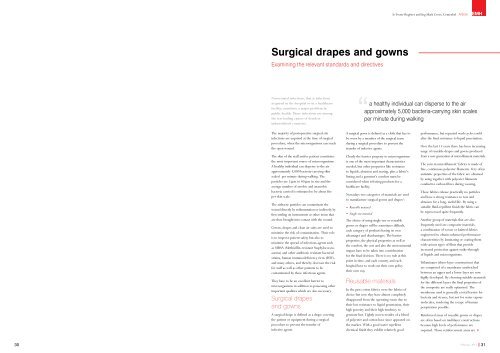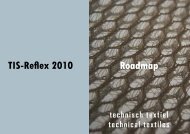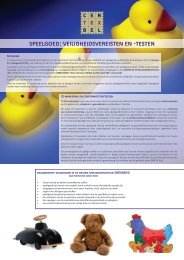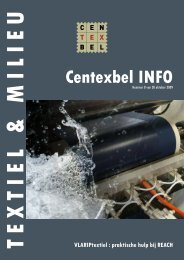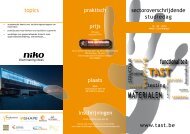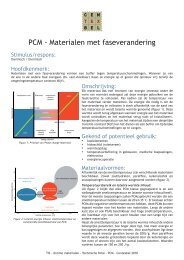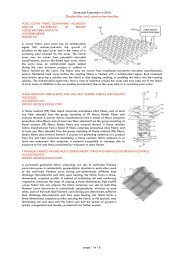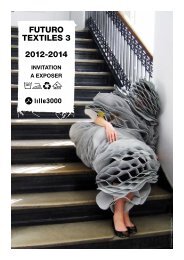Surgical drapes and gowns - Centexbel
Surgical drapes and gowns - Centexbel
Surgical drapes and gowns - Centexbel
Create successful ePaper yourself
Turn your PDF publications into a flip-book with our unique Google optimized e-Paper software.
Ir Yvette Rogister <strong>and</strong> Ing Mark Croes, <strong>Centexbel</strong> Article<br />
<strong>Surgical</strong> <strong>drapes</strong> <strong>and</strong> <strong>gowns</strong><br />
Examining the relevant st<strong>and</strong>ards <strong>and</strong> directives<br />
Nosocomial infections, that is infections<br />
acquired in the hospital or in a healthcare<br />
facility, constitute a major problem in<br />
public health. These infections are among<br />
the ten leading causes of death in<br />
industrialised countries.<br />
a healthy individual can disperse to the air<br />
approximately 5,000 bacteria-carrying skin scales<br />
per minute during walking<br />
The majority of postoperative surgical site<br />
infections are acquired at the time of surgical<br />
procedure, when the microorganisms can reach<br />
the open wound.<br />
The skin of the staff <strong>and</strong>/or patient constitutes<br />
the most important source of microorganisms.<br />
A healthy individual can disperse to the air<br />
approximately 5,000 bacteria-carrying skin<br />
scales1 per minute during walking. The<br />
particles are 5 µm to 60 µm in size <strong>and</strong> the<br />
average number of aerobic <strong>and</strong> anaerobic<br />
bacteria carried is estimated to be about five<br />
per skin scale.<br />
The airborne particles can contaminate the<br />
wound directly by sedimentation or indirectly by<br />
first settling on instruments or other items that<br />
are then brought into contact with the wound.<br />
Gowns, <strong>drapes</strong> <strong>and</strong> clean air suits are used to<br />
minimise the risk of contamination. Their role<br />
is to improve patient safety but also to<br />
minimise the spread of infectious agents such<br />
as MRSA (Methicillin-resistant Staphylococcus<br />
aureus) <strong>and</strong> other antibiotic resistant bacterial<br />
strains, human immunodeficiency virus (HIV),<br />
<strong>and</strong> many others, <strong>and</strong> thereby decrease the risk<br />
for staff as well as other patients to be<br />
contaminated by these infectious agents.<br />
They have to be an excellent barrier to<br />
microorganisms in addition to possessing other<br />
important qualities which are also necessary.<br />
<strong>Surgical</strong> <strong>drapes</strong><br />
<strong>and</strong> <strong>gowns</strong><br />
A surgical drape is defined as a drape covering<br />
the patient or equipment during a surgical<br />
procedure to prevent the transfer of<br />
infective agents.<br />
A surgical gown is defined as a cloth that has to<br />
be worn by a member of the surgical team<br />
during a surgical procedure to prevent the<br />
transfer of infective agents.<br />
Clearly the barrier property to microorganisms<br />
is one of the most important characteristics<br />
needed, but other properties like resistance<br />
to liquids, abrasion <strong>and</strong> tearing, plus a fabric’s<br />
linting <strong>and</strong> a garment’s comfort must be<br />
considered when selecting products for a<br />
healthcare facility.<br />
Nowadays two categories of materials are used<br />
to manufacture surgical <strong>gowns</strong> <strong>and</strong> <strong>drapes</strong> 2 :<br />
– Reusable material<br />
– Single-use material<br />
The choice of using single-use or reusable<br />
<strong>gowns</strong> or <strong>drapes</strong> will be sometimes difficult,<br />
each category of products having its own<br />
advantages <strong>and</strong> disadvantages. The barrier<br />
properties, the physical properties as well as<br />
the comfort, the cost <strong>and</strong> also the environmental<br />
impact have to be taken into consideration<br />
for the final decision. There is no rule at this<br />
point in time, <strong>and</strong> each country <strong>and</strong> each<br />
hospital have to work out their own policy<br />
their own way.<br />
Reusable materials<br />
In the past cotton fabrics were the fabrics of<br />
choice but now they have almost completely<br />
disappeared from the operating room due to<br />
their low resistance to liquid penetration, their<br />
high porosity <strong>and</strong> their high tendency to<br />
generate lint. Tightly woven textiles of a blend<br />
of polyester <strong>and</strong> cotton have since appeared on<br />
the market. With a good water repellent<br />
chemical finish they exhibit relatively good<br />
performance, but repeated wash cycles could<br />
alter the final resistance to liquid penetration.<br />
Over the last 15 years there has been increasing<br />
usage of reusable <strong>drapes</strong> <strong>and</strong> <strong>gowns</strong> produced<br />
from a new generation of microfilament materials.<br />
The yarn in microfilament 3 fabrics is made of<br />
fine, continuous polyester filaments. Very often<br />
antistatic properties of the fabric are obtained<br />
by using together with polyester filaments<br />
conductive carbon fibres during weaving.<br />
Those fabrics release practically no particles<br />
<strong>and</strong> have a strong resistance to tear <strong>and</strong><br />
abrasion for a long, useful life. By using a<br />
suitable fluid-repellent finish the fabric can<br />
be reprocessed quite frequently.<br />
Another group of materials that are also<br />
frequently used are composite materials,<br />
a combination of woven or knitted fabrics<br />
engineered to obtain enhanced performance<br />
characteristics by laminating or coating them<br />
with various types of films that provide<br />
increased protection against strike-through<br />
of liquids <strong>and</strong> microorganisms.<br />
Trilaminates (three-layer construction) that<br />
are comprised of a membrane s<strong>and</strong>wiched<br />
between an upper <strong>and</strong> a lower layer are now<br />
highly developed. By choosing suitable materials<br />
for the different layers the final properties of<br />
the composite are really optimised. The<br />
membrane used is generally a total barrier for<br />
bacteria <strong>and</strong> viruses, but not for water vapour<br />
molecules, rendering the escape of human<br />
perspiration possible.<br />
Reinforced areas of reusable <strong>gowns</strong> or <strong>drapes</strong><br />
are often based on multilayer constructions<br />
because high levels of performance are<br />
required. Those reinforcement areas are 4<br />
30 February 2013 31
Article Medical Workwear <strong>and</strong> Textiles<br />
Medical Workwear <strong>and</strong> Textiles Article<br />
principally located around the patient wound,<br />
for <strong>drapes</strong>, <strong>and</strong> on the front <strong>and</strong> sleeves of<br />
the gown.<br />
Single-use materials<br />
Nonwoven materials are the essential<br />
component of single-use surgical <strong>gowns</strong><br />
<strong>and</strong> <strong>drapes</strong>.<br />
They are based on various forms of natural<br />
<strong>and</strong> synthetic fibres; that is, components such<br />
as wood pulp <strong>and</strong> cotton, or polyester,<br />
polyolefin respectively 4 .<br />
Based on the way the links between the fibres<br />
take place in the nonwoven - chemically,<br />
physically, mechanically, thermally - nonwovens<br />
are segmented in different categories.<br />
For surgical <strong>gowns</strong> a nonwoven should be soft<br />
<strong>and</strong> breathable while a high level of barrier<br />
protection is also required. Several types of<br />
nonwovens can meet these requirements.<br />
Spunlaced materials, SMS (Spunbond/<br />
Meltblown/Spunbond – consisting of three<br />
thermally bonded layers, generally based on<br />
polypropylene) or SMMS (Spunbond/<br />
Meltblown/Meltblown/Spunbond) can be used.<br />
Owing to the firm bonding of the fibres<br />
these materials are particularly low-linting<br />
<strong>and</strong> abrasion-resistant, yet extremely soft<br />
<strong>and</strong> breathable, providing excellent<br />
wearing comfort.<br />
For <strong>drapes</strong> either coated wet, dry laid or<br />
multilayer, SMS are used.<br />
Like reusable, single-use <strong>gowns</strong> <strong>and</strong> <strong>drapes</strong> can<br />
be reinforced for specific applications <strong>and</strong> in<br />
some areas. When necessary they are<br />
reinforced with other material such as a plastic<br />
film, or are used in double or triple layers in<br />
order to achieve the requirements of the<br />
operating room.<br />
Medical Devices<br />
Directive<br />
As a medical device, textiles used in operating<br />
theatres have to be conform with the<br />
requirements of the European Medical Devices<br />
Directive MDD 93/42/EEC 5 (last technical<br />
revision being brought about by the Directive<br />
2007/47/EC).<br />
surgical <strong>drapes</strong>, <strong>gowns</strong> <strong>and</strong> clean air suits are classified<br />
as Class I (Non Invasive) Medical Devices, <strong>and</strong> must<br />
conform to chemical, physical <strong>and</strong> microbiological<br />
properties as well as meet specified safety parameters<br />
According to the MDD medical devices should<br />
provide patients, users <strong>and</strong> third parties with a<br />
high level of protection <strong>and</strong> attain the<br />
performance levels attributed to them<br />
by the manufacturer.<br />
Devices are divided into four risk classes:<br />
Class I, Class IIa, Class IIb <strong>and</strong> Class III.<br />
Classification is carried out in accordance<br />
with Annex IX of the MDD.<br />
<strong>Surgical</strong> <strong>drapes</strong>, <strong>gowns</strong> <strong>and</strong> clean air suits are<br />
classified as Class I (Non Invasive) Medical<br />
Devices. Those medical devices have to<br />
conform to chemical, physical <strong>and</strong><br />
microbiological properties as well as meet<br />
specified safety parameters of use, storage,<br />
transport <strong>and</strong> labelling.<br />
For medical devices belonging to Class I<br />
the responsibility of safety for putting the<br />
medical device on the market is taken by<br />
the manufacturer.<br />
For other medical devices (Classes II <strong>and</strong> III)<br />
manufacturer <strong>and</strong> independent assessment<br />
centres such as notified bodies, national<br />
agencies, <strong>and</strong> the European commission have<br />
to work together.<br />
European<br />
st<strong>and</strong>ardization<br />
EN 13795<br />
The EN 13795 European St<strong>and</strong>ard for surgical<br />
<strong>gowns</strong> <strong>and</strong> <strong>drapes</strong> specifies the performance<br />
requirements, manufacturing st<strong>and</strong>ards <strong>and</strong><br />
testing methods for both reusable <strong>and</strong> singleuse<br />
products.<br />
This st<strong>and</strong>ard has been written in the spirit of<br />
the European directive <strong>and</strong> aims at preventing<br />
the transfer of infections between medical staff<br />
<strong>and</strong> patients during surgical operations <strong>and</strong><br />
other invasive interventions. It provides the<br />
technical link to comply with the European<br />
MDD directive.<br />
Moreover, the st<strong>and</strong>ard wants to guarantee the<br />
same safety <strong>and</strong> performance levels for all<br />
products, disposable or reusable articles alike,<br />
<strong>and</strong> this during the entire product life.<br />
During March 2011 a new version of the<br />
st<strong>and</strong>ard was published. Whereas the previous<br />
version (dated 2009) was divided in three parts<br />
- EN 13795-1:2002+A1 :2009, EN 13795-2<br />
:2004+A1:2009, <strong>and</strong> EN 13795-<br />
3:2006+A1:2009 - the recent version of<br />
2011 is a unique document merging the<br />
three previous parts.<br />
EN 13795 - 2011: Title<br />
<strong>Surgical</strong> <strong>drapes</strong>, <strong>gowns</strong> <strong>and</strong> clean air suits, used<br />
as medical devices for patients, clinical staff <strong>and</strong><br />
equipment - General requirements for<br />
manufacturers, processors <strong>and</strong> products, test<br />
methods, performance requirements <strong>and</strong><br />
performances levels.<br />
EN 13795 - 2011:<br />
Content<br />
The st<strong>and</strong>ard is structured as follows:<br />
1. Scope<br />
2. Normative references<br />
3. Terms <strong>and</strong> definitions<br />
4. Performance requirements<br />
5. Testing<br />
6. Manufacturing <strong>and</strong> processing requirements<br />
7. Information to be supplied by the<br />
manufacturer or processor<br />
The annex A explains the significant changes<br />
that have been made between this new st<strong>and</strong>ard<br />
<strong>and</strong> the previous edition.<br />
The annex B defines the test methods.<br />
The annex C gives information concerning the<br />
prevention of infection in the operating room.<br />
The annex D gives information concerning<br />
further characteristics like comfort, adhesion<br />
<strong>and</strong> liquid control.<br />
What are the test<br />
methods used?<br />
The testing for the evaluation of the<br />
performance of products has to be done<br />
according to the test methods specified<br />
in annex B.<br />
All the tests have to be performed on<br />
the finished products <strong>and</strong> if the product<br />
is used after sterilisation, testing has to<br />
be performed on products after sterilisation<br />
with the exception of the microbial<br />
cleanliness test. Testing includes potential<br />
weak spots.<br />
Besides physical tests which are well<br />
known like:<br />
– Tensile strength in dry <strong>and</strong> wet states -<br />
EN 29073-3<br />
– Burst strength in dry <strong>and</strong> wet states -<br />
EN 13938-1<br />
– Resistance to fluid penetration - EN 20811<br />
Other more specific characteristics have to be<br />
measured. These include:<br />
– Cleanliness - microbial - EN ISO 11737-1<br />
Microbial cleanliness determines the bioburden or<br />
the total content of viable microorganisms on the<br />
product. It has to be done on the finished product<br />
before sterilisation. The test results are expressed as<br />
a number of CFU (colony forming unit)/100 cm 2<br />
Introduction of the contaminated talc powder - ISO 22612 test<br />
– Cleanliness - particulate matter - ISO 9073-10<br />
<strong>and</strong> Linting - ISO 9073-10<br />
The ISO st<strong>and</strong>ard specifies a test method for<br />
measuring the linting in the dry state.<br />
The EN13795 brings the following amendments<br />
to the st<strong>and</strong>ard.<br />
Only particles whose size range is between 3 µm<br />
<strong>and</strong> 25 µm have to be considered as linting, due<br />
to the fact that only particles of this size range are<br />
considered to be capable of carrying microorganisms.<br />
The cleanliness particulate matter (PM) corresponds<br />
to the particle counts from steps 30 s, 60 s<br />
<strong>and</strong> 90 s of the linting measurement that are<br />
added together.<br />
The results of the test are expressed as follows:<br />
– Linting = log 10<br />
(lint count ≥ 3µ)<br />
– Cleanliness - Particulate matter: IPM (index for<br />
particulate matter) = log 10<br />
(PM ≥ 3µ )<br />
– Resistance to microbial penetration - dry -<br />
ISO 22612<br />
This test method provides a means for assessing the<br />
resistance to penetration through barrier materials<br />
of bacteria-carrying particles.<br />
A talc powder is used as a carrier of germs. The method<br />
establishes the quantity of bacteria that can penetrate<br />
through the test material being carried on talcum<br />
powder. Test results are expressed in the CFU (colony<br />
forming units) that were observed on the agar plate.<br />
– Resistance to microbial penetration - wet -<br />
ISO 22610<br />
This International St<strong>and</strong>ard specifies a test method,<br />
with associated test apparatus (see photo), which is<br />
used to determine the resistance of a material to the<br />
penetration of bacteria, carried by a liquid,<br />
when subjected to mechanical rubbing.<br />
Bacteria that have passed through the material<br />
Requirement: ≤ 300 CFU<br />
Test results are expressed as I B<br />
‘Barrier Index’.<br />
A total barrier material gives the maximum<br />
achievable value of 6.0.<br />
When the values are below 6.0 it means that<br />
a penetration of bacteria is possible: 2.8 as I B<br />
is the limit which has been accepted for<br />
some products.<br />
Performance <strong>and</strong><br />
requirements<br />
To comply with EN 13795 products should<br />
meet all the requirements specified in either<br />
tables 1, 2 or 3 of the st<strong>and</strong>ard, as appropriate<br />
to the product.<br />
These minimum values account for the<br />
circumstances of the surgical operation,<br />
therefore they distinguish between products<br />
for st<strong>and</strong>ard performances <strong>and</strong> products<br />
for higher performances on the one h<strong>and</strong>,<br />
<strong>and</strong> between the critical <strong>and</strong> less critical<br />
zones of the product on the other h<strong>and</strong>.<br />
The critical zone of a product has a greater<br />
chance of being involved in the transfer of<br />
infection carriers on the operation site, or on<br />
the invasive zone, or vice versa. For example,<br />
the front piece <strong>and</strong> the sleeves of surgical<br />
<strong>gowns</strong> are in the immediate proximity of the<br />
operation site.<br />
A product for st<strong>and</strong>ard performances or<br />
high performances is defined in function<br />
by its exposure to biological or other fluids,<br />
to mechanical pressure or by the duration<br />
of a surgical operation. 4<br />
Illustration of the test system ISO 22610<br />
32 February 2013<br />
February 2013 33
Article Medical Workwear <strong>and</strong> Textiles<br />
Medical Workwear <strong>and</strong> Textiles Article<br />
st<strong>and</strong>ard EN13795 is aimed principally at the protection of the<br />
patient; this determines the direction in which the sample is<br />
brought into contact with the contaminating agent during the test<br />
The following test methods to measure<br />
the comfort properties of <strong>gowns</strong> <strong>and</strong><br />
<strong>drapes</strong> can be used.<br />
– Air permeability - ISO 9237<br />
– Skin model - ISO 11092 - EN31092<br />
– Thermal manikin - EN ISO 15831 -<br />
ASTM F2370<br />
As an example, Table 1 gives the general<br />
requirements of the EN13795 for <strong>gowns</strong>.<br />
a. Test conditions: challenge concentration<br />
10 8 CFU/g talc <strong>and</strong> 30 min vibration time.<br />
b. The Least Significant Difference (LSD) for I B<br />
when estimated using EN ISO 22610, was<br />
found to be 0.98 at the 95% confidence level.<br />
This is the minimum difference needed to<br />
distinguish between two materials thought to<br />
be different. Thus materials varying by up to<br />
0.98 I B<br />
are probably not different; materials<br />
varying by more than 0.98 I B<br />
probably are<br />
different. (The 95% confidence levels means<br />
that an observer would be correct 19 times<br />
out of 20 to accept these alternatives).<br />
c. I B<br />
= 6.0 for the purpose of this European<br />
St<strong>and</strong>ard means: no penetration. I B<br />
= 6.0<br />
is the maximum achievable value.<br />
Action for manufacturers<br />
or processors<br />
According to their performance, surgical<br />
<strong>drapes</strong> <strong>and</strong> <strong>gowns</strong> must be further<br />
categorised <strong>and</strong> defined as st<strong>and</strong>ard or<br />
high performance devices.<br />
The manufacturer <strong>and</strong> processor should<br />
document that the requirements set down<br />
in the EN13795 st<strong>and</strong>ard are met.<br />
Characteristic Unit EN 13795 requirements<br />
Validated manufacturing <strong>and</strong> procedures<br />
should be used including validation of<br />
the product itself, validation of each step<br />
of manufacture <strong>and</strong> processing, <strong>and</strong><br />
recording of each important key variable.<br />
If the manufacturer or processor<br />
differentiates between critical <strong>and</strong> less<br />
critical areas, he has to supply information<br />
to clearly identify them.<br />
Further characteristics<br />
St<strong>and</strong>ard EN13795 also mentions some<br />
interesting additional properties such as ‘liquid<br />
control’, adhesion properties or comfort.<br />
Table 1. Characteristics <strong>and</strong> use requirements to be assessed with surgical <strong>gowns</strong><br />
Image: Manikin of <strong>Centexbel</strong><br />
Besides tests that have to prove the<br />
conformity of the product, the<br />
European directive introduces the<br />
notion of risk analysis by proposing<br />
the following tests:<br />
– Non-toxicity of the medical device -<br />
ISO 10993-5<br />
Image: Cytotoxicity test on fibroblasts cells<br />
– Measurement of the electrical risk -<br />
ISO 2878 (BS2050) <strong>and</strong> EN 1149<br />
– Protection against laser beams<br />
– ISO 11810-1: primary ignition <strong>and</strong><br />
penetration<br />
– ISO 11810-2: secondary ignition<br />
Image: Apparatus developed by <strong>Centexbel</strong> for the<br />
evaluation of the laser protection<br />
3. Univ Prof Dr Ojan Assadian, Gerhard Fluch,<br />
Administrative Director Norbert Grass, Dr Milo Halabi,<br />
Dr Markus Hell, Prim. Univ Prof Dr Harald Hertz,<br />
Prim Dr Peter Zenz, 2011, Reusable surgical fabrics -<br />
Consensus statement- State of the art 2011, CliniCum<br />
special edition October 2011.<br />
4. William A Rutala, PhD, MPH <strong>and</strong> David J Weber, MD,<br />
MPH, 2001, A review od single-use <strong>and</strong> reusable <strong>gowns</strong><br />
<strong>and</strong> <strong>drapes</strong> in health care, Infection Control <strong>and</strong><br />
Hospital epidemiology, 22, (4), p248-257.<br />
5. European Council Directive 93/42/EEC of 14 June<br />
1993 concerning medical devices.<br />
Authors<br />
Ir Yvette Rogister,<br />
Head of Microbiological Laboratory<br />
Yvette Rogister joined <strong>Centexbel</strong> 23 years<br />
ago after one year of teaching at the<br />
University of Louvain-La-Neuve. As an<br />
engineer in chemistry she started her career as a researcher<br />
<strong>and</strong> followed a lot of projects concerning textiles <strong>and</strong> surface<br />
modifications by different processes. Later she contributed<br />
largely to the development of the laboratory of microbiology<br />
<strong>and</strong> hygiene in relation to textiles. By participating in<br />
different st<strong>and</strong>ardisation committees <strong>and</strong> developing testing<br />
methods she now has extensive experience in numerous<br />
different fields including antimicrobial treatments, barrier<br />
textiles, medical textiles <strong>and</strong> medical devices.<br />
St<strong>and</strong>ard performance<br />
High performance<br />
Ing Mark Croes<br />
Critical product<br />
area<br />
Less critical<br />
product area<br />
Critical product area<br />
Resistance to microbial penetration - dry CFU Not required ≤ 300 a Not required ≤ 300 a<br />
Less critical product area<br />
Resistance to microbial penetration - wet I B<br />
≥ 2.8 b Not required 6.0 b c Not required<br />
Cleanliness - microbial CFU/100 cm 2 ≤ 300 ≤ 300 ≤ 300 ≤ 300<br />
Cleanliness - particulate matter IPM ≤ 3.5 ≤ 3.5 ≤ 3.5 ≤ 3.5<br />
Linting Log (10)<br />
(lint count) ≤ 4.0 ≤ 4.0 ≤ 4.0 ≤ 4.0<br />
Resistance to liquid penetration cm H 2<br />
O ≥ 20 ≥ 10 ≥ 100 ≥ 10<br />
Bursting strength - dry kPa ≥ 40 ≥ 40 ≥ 40 ≥ 40<br />
Bursting strength - wet kPa ≥ 40 Not required ≥ 40 Not required<br />
Tensile strength - dry N ≥ 20 ≥ 20 ≥ 20 ≥ 20<br />
Tensile strength - wet N ≥ 20 Not required ≥ 20 Not required<br />
Who is protected?<br />
St<strong>and</strong>ard EN13795 is aimed principally at the<br />
protection of the patient; this determines the<br />
direction in which the sample is brought into<br />
contact with the contaminating agent during<br />
the test.<br />
If the manufacturer also claims the protection<br />
of the medical staff, the surgical gown will no<br />
longer be considered as a medical device but as<br />
PPE (personal protection equipment).<br />
In this case, the product has to comply with<br />
the corresponding directive 89/686/EEC<br />
(protective clothing) <strong>and</strong> st<strong>and</strong>ard EN14126:<br />
Protective Clothing. Performance requirements<br />
<strong>and</strong> tests methods for protective clothing<br />
against infective agents. g<br />
References<br />
1. European St<strong>and</strong>ard EN13795, 2011, <strong>Surgical</strong><br />
<strong>drapes</strong>, <strong>gowns</strong> <strong>and</strong> clean air suits, used as medical devices<br />
for patiens, clinical staff <strong>and</strong> equipment - General<br />
requirements for manufacturers, processors <strong>and</strong><br />
products, test methods, performance requirements <strong>and</strong><br />
performance levels.<br />
2. Barbara J Gruendemann, RN, MS, FAAN, CNOR, 2002,<br />
Taking Cover: Single-use vs Reusable <strong>gowns</strong> <strong>and</strong> <strong>drapes</strong>,<br />
Infection Control Today magazine of March, p.32-34.<br />
After a career of almost 15 years in<br />
technical service <strong>and</strong> product development<br />
servicing the European pharmaceutical,<br />
paper <strong>and</strong> textile markets with an American<br />
specialty chemicals’ manufacturer, Croes joined <strong>Centexbel</strong><br />
ten years ago as a Technological <strong>and</strong> Innovation Consultant,<br />
supporting the activities in the field of Health <strong>and</strong> Safety<br />
in the laboratory.<br />
<strong>Centexbel</strong>, Belgian Textile Research Centre<br />
The Belgium based laboratory offers highly specialised<br />
technological services including customised advice, measuring<br />
<strong>and</strong> testing, certification, process innovation <strong>and</strong> product<br />
development to the manufacturers of medical <strong>and</strong> hygiene<br />
oriented textile products. The laboratory specialises in the<br />
evaluation of cleanliness <strong>and</strong> barrier properties - both particle<br />
<strong>and</strong> microbial - of medical <strong>and</strong> hygiene products.<br />
34 February 2013<br />
February 2013 35


